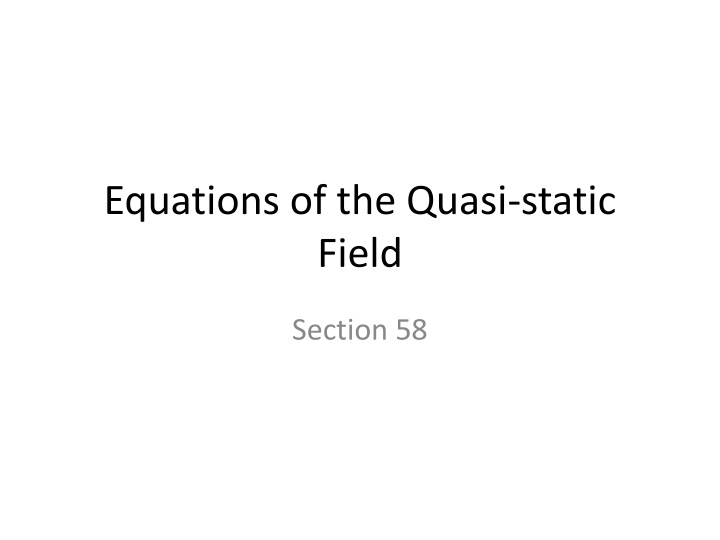
Equations of Quasi-Static Fields in Conductors and Electrodynamics
Explore the implications of quasi-static fields in conductors, distinguishing between inside and outside effects. Understand the relationship between E-fields, B-fields, and internal currents in extended conductors at low frequencies. Ohm's law, conductor dimensions, and field proximity are key factors in analyzing electromagnetism in matter.
Uploaded on | 1 Views
Download Presentation

Please find below an Image/Link to download the presentation.
The content on the website is provided AS IS for your information and personal use only. It may not be sold, licensed, or shared on other websites without obtaining consent from the author. If you encounter any issues during the download, it is possible that the publisher has removed the file from their server.
You are allowed to download the files provided on this website for personal or commercial use, subject to the condition that they are used lawfully. All files are the property of their respective owners.
The content on the website is provided AS IS for your information and personal use only. It may not be sold, licensed, or shared on other websites without obtaining consent from the author.
E N D
Presentation Transcript
Equations of the Quasi-static Field Section 58
1. Until now, we considered only static electric and magnetic fields. We used only to derive the magnetic energy. 2. Electrodynamics in matter depends strongly on the nature of the medium and on the frequency. Here we consider extended conductors in variable external magnetic fields at low frequencies (usually microwaves and below).
3. First assumption: wavelength ~ c/ >> body dimension l The field at P due to the proximity of the conductor is the same in both cases, except that the magnitude and sign of the field at P in the latter case is changing monotonically as Exp[-i t]. P has to be close enough to the conductor to avoid retardation effects: The field at P now is due to fields at the conductor now, not at earlier time. Requires: distance to P << .
The equations of the static field should hold at the field point P, outside the conductor, where there is no charge current. Let l be the dimension of the conductor
4. Inside the conductor, the equations are different because the conduction currents are non-zero with j = E We assume that Ohm s law holds with the DC value of the conductivity: This requires that the oscillation period of E >> electron response time . Otherwise E changes sign before macroscopic charge flow can build up.
5. The given quasistatic field equations in the conductor are local relations: The j at a given point depends only on the E at that point, and not at other points. Local relations Requires: electron mean free path << characteristic length for changes in field. Otherwise j at given point could be determined by E at distant points.
6. The E-field appear inside the conductor is induced by the variable B-field small, but don t discard it inside the conductor. Any external slowly-varying E-field does not penetrate, but the B-field does. Thus, dB/dt is the source for a macroscopic E-field inside. This is the internal E-field that drives the internal currents j
Induced E-field distribution does not look like the external E0-field distribution
If H is known, then Gives j(r,t). and Then Ohm s law Gives E(r,t) We can eliminate j and E to get a differential equation for H and B
7. To eliminate B, we need to assume a relation between B and H. To simplify the equation, we need to assume medium is homogeneous.
We get two equations for H, which suffice to find it everywhere at all times Same as the heat conduction equation (Fourier s equation): H Inside conductor Outside conductor Thermometric conductivity z Time rate of change of H(t) and curvature of H(z) are proportional at a given point
8. Need boundary conditions on H to solve Fourier equation for H(z,t) Since j is finite at the interface, see (30.2) For a non-ferromagnetic medium, or ferromagnetic one at high frequency, = 1. Then B = H, and boundary conditions become H1 = H2.
9. Boundary conditions on normal component of E En is usually zero at the outer boundary with dielectric (air).
10.Boundary condition on Et for composite conductor. E1t = E2t For a conductor with different parts of different , Et is continuous at each interface. This is a boundary condition for H that we can use to solve Fourier equation for H in the case that the conductor is piecewise homogeneous. H silver copper 1 2 0 z
11. Suppose external H-field is suddenly removed. The induced E and jdon t vanish immediately. Neither does H in or around the conductor. The decay of the field is determined by Fourier s equation Seek solutions of the form This is an eigenvalue equation. For a given conductor, solutions Hm(x,y,z) that satisfy the boundary conditions exist only for certain m (real and positive). {Hm(x,y,z)} = complete orthogonal set of eigenvectors.
The rate of decay is determined mainly by the smallest m. Call it 1 l = dimension of the conductor = largest dimension of the problem Gives longest , smallest High conductivity and large conductor give slow decay
